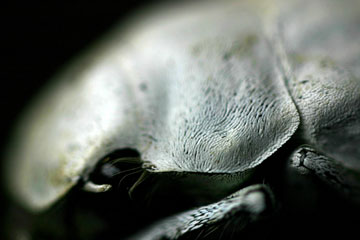Biomimicry of beetle could produce whiter teeth
Biomimicry of white beetle could produce whiter teeth
Rhett A. Butler, mongabay.com
January 18, 2007
A pure white beetle found in the forests of southeast Asia could eventually lead to “brilliant white ultra-thin materials” including whiter teeth and finer paper, according to research led by scientists at the University of Exeter.
Writing in the January 19 issue of the journal Science, researchers describe the ultra-thin surface structure of the brilliant white shell of the Cyphochilus beetle and note that mimicry of its scales could produce thinner, whiter coatings. A news release from the University of Exeter elaborates:
-
At one 200th of a millimetre thick, the beetle’s scales are ten times thinner than a human hair. Industrial mineral coatings, such as those used on high quality paper, plastics and in some paints, would need to be twice as thick to be as white.
 Close up of the Cyphochilus beetle. Whiteness is relatively rare in animals but researchers say the Cyphochilus has developed scales that effectively scatter all visible wavelengths of light in order to appear white. Its white color helps the insect better camouflage among white fungi found in its native habitat. Image copyright Pete Vukusic of the University of Exeter. |
“This kind of brilliant whiteness from such a thin sample is rare in nature. As soon as I saw it, every instinct told me that the beetle was something very special,” said Dr Pete Vukusic of the University of Exeter’s School of Physics and lead author of the paper. “In future, the paper we write on, the colour of our teeth and even the efficiency of the rapidly emerging new generation of white light sources will be significantly improved if technology can take and apply the design ideas we learn from this beetle.”
Vukusic says that the flat, overlapping scales that cover the beetle’s body, head and legs are structured to scatter all visible wavelengths of light in order to appear white. The scattering by the scales is far more efficient than the fibers in white paper or the enamel on teeth, according to Vukusic.
Related articles
Shark biomimicry produces renewable energy system — 11/1/2006
An Australian firm has developed a renewable tidal energy conversion system based on the highly efficient fin structure of shark, tuna, and mackerel. BioPower Systems Pty Ltd., a renewable energy systems company based in Eveleigh, New South Wales, says that its bioSTREAM technology for converting tidal and marine current energy into electricity is modeled on biological species, such as shark and tuna, that use Thunniform-mode swimming propulsion.
Nature’s engineering shows butterfly innovation — 12/7/2006
Flourescent patches on the wings of African swallowtail butterflies work in a very similar, but more efficient way to high emission light emitting diodes (LEDs) used in electronic equipment and displays, according to University of Exeter research published in Science.
more on biomimicry
This article is based on a news release from the University of Exeter.